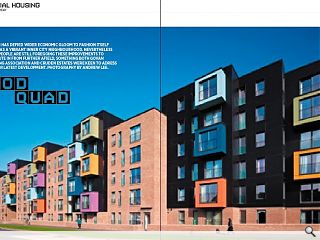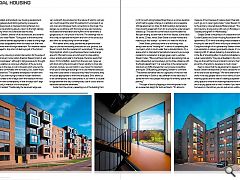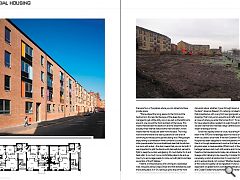Golspie Street
4 Aug 2012
Govan has defied wider economic gloom to fashion itself anew as a vibrant inner city neighbourhood. Nevertheless most people are still foregoing these improvements to commute in from further afield, something both Govan Housing Association and Cruden Estates were keen to address in their latest development. Photography by Andrew Lee.
Adrian Stewart, director of do-architecture, and scheme designer told Urban Realm: “Going back to the terrace that was there before seemed appropriate to create a strong edge. All the terraces disappeared when the roads took their new form and these were the high watermark. For whatever reason they managed to stop short of destroying all of the historic stock.”
The jaunty colouring is a bold intervention for the edge of the Central Govan Conservation Area but Stewart insists it was never a “showstopper”, although it did give pause for thought. In fact the palette is a conscious reflection of the surviving wally closes in the area, a nod to the past which ensures the build remains comfortable with its history. Do’s Judith Wylie Macleod observed: “The palette developed in tandem with the form. If you were trying to make a modern tenement you would create a line of bays down the road but we tried to be much more contemporary in that the bays don’t align symmetrically, it makes it a lot more playful.”
Stewart added: “Traditionally the tenement edge was very solid with big windows but the nature of solid to void was very much toward the solid. We wanted to try and open it up a lot more and introduce fresh connections to the street. The danger we could have with this long terrace was monotony, the traditional fenestration and rhythm of the tenements is gorgeous but it’s very much of its time. The challenge was to find a way to replicate the rhythm and form of the blocks but also allow six storeys along the whole length.”
With ashlar stone, sadly, prohibitively expensive these days its use was necessarily precluded on cost grounds, but Stewart insists that the material isn’t second best: “It’s a really forgiving brick which is good because there is quite a large area of it. We had to know at which point to stop adding colour and physical relief to the façade, the brick quiets that down. I’m from Belfast, Jude’s from there as well, I grew up with brick all my life and loved it, there’s solidity to it but also a human module, you can hold it in your hand. It’s important when you’re looking at buildings not to use materials because they were used before or because they match and blend, they should be appropriate to their time and place. Brick allows us to be contemporary and it also blends in, so I think it is a subtle bridge between the very contemporary use of colour and the traditional sandstone tenements.”
Aside from the primary repeating run of the building from north to south along Golspie Street there is a corner elevation which had to juggle a change in orientation and a separate infill development on Shaw St. Both buildings demanded a more inventive approach from Do to ensure the wider project stacked up. This sees the corner block accommodate four flats per landing, double that of the front façade, so that each lift serves 22 flats, whilst Shaw Street is timber framed and reaches just four storeys - so there is no need for lifts at all.
Shaw Street, previously home to a workshop, was always seen as the “missing link” in terms of completing the courtyard, which is much wider than a standard block. It’s a space which is intended to feel safe and secure to encourage residents to socialise but is largely given over to vehicles. Stewart notes: “We would have had a lot less parking had we been allowed but we have always got to strike a balance with the Roads department.” Car ownership in the rented sector stands at just 30% whereas the Council were (incredibly) looking for 120% parking, prompting Stewart to comment: “The blanket standards take no cognizance of the fact that car ownership in Govan is very different to the west end. If asked we think most people would opt for amenity space over parking.”
The sight of laundry flapping in the wind proved to be an unexpected delight for both architects: “It’s almost a measure of trust because if a place doesn’t feel safe washing won’t go out in case it gets stolen,” notes Stewart. Referring to the primary coloured façade Macleod joked: “There’s a strict laundry drying policy with reds on Mondays, blues on Tuesdays and green on Wednesdays.”
Golspie Street is the product of collaboration between Cruden Estates and Govan Housing Association offering 102 apartments, 42 of which are being made available as low cost housing for sale and 60 which will be put forward for rent. Citing the strength of this partnership Stewart noted: “There is an aspiration to deliver good quality spaces; it’s not about making profit, it’s about delivering. Associations are involved in the life of a building after it is built and inhabited so there is a dual responsibility. They are embedded in the community; they are there all the time and tenants come to them so the proximity of tenants to developer is much closer.”
Keen to stress that the development is deeper than its façade Stewart stressed that Do have utilised the full depth of the site to best advantage: “We were aware that there are shifts in the way people want to live in terms of cooking and washing spaces and the idea of creating a separate store and utility space to remove the washing machine from the kitchen and a drying space next to that. It means if you want to do homework in the kitchen you can pull across a sliding door, there are four or five places where you can retreat and have private space.
“We’ve placed the living spaces to the front and the bedrooms to the rear. But because of the deep site we managed to get a little utility core in as well, so the bathrooms are all in one zone at the front and back of the house. This means that between the bedroom and the street there are actually three internal walls and the main elevation, which means that the houses are silent from the back. The living room and the kitchen are side by side and it took a bit of convincing to introduce this pocket sliding door. Many people enjoy having a conversation when someone’s cooking but other people prefer the more traditional idea that the kitchen is a room with a door - the door means that you can do both. It was important to split the blocks with stairwells but we had to fight to keep the curtain wall glazing. It’s much better for it and feels safer; it is a much more comfortable place to be and we now try to encourage people to come out with plants and take ownership of the lift lobbies. ”
Fastlink, a limited stop bus link running on a dedicated road, may pass along Golspie Street and that dictated we push the building back 4 or 5m, leaving a grass strip at the front which could eventually become the Fastlink lane. “There’s discussion about whether it goes through Govan or round the back” observes Stewart. It’s certainly not ideal because that presented us with a very fast road going past with no stopping. That’s not just an acoustic and traffic problem but an issue of where you enter the homes from.” To resolve this Do have opted to allow residents to walk through the building via each stairwell and inserted a large central access pend to impart a feeling of arrival.
Govan has rapidly come full circle, recovering from its nadir in the 1970s to increasingly assert its role as a bustling inner city district once more. If the new Southern General Hospital has been designed to mend the patients within then it is through developments such as this that wider physical repair is made possible. Whilst much of Govan’s heritage has been lost much still remains and it is heartening therefore that developments today can embrace that proud lineage whilst refusing to be cowed by it. Golspie Street isn’t necessarily a catch all solution but it is a product of Govan and its extraordinarily rich context. Whether developments of this scale and quality can be repeated in future is largely dependent on global factors outwith local influence but GHA and Cruden Estates have demonstrated the market demand for new inner city tenements.
|
|
Read next: Brymbo Steelworks
Read previous: Manifesto: Summer 2012
Back to August 2012
Browse Features Archive
Search
News
For more news from the industry visit our News section.
Features & Reports
For more information from the industry visit our Features & Reports section.





